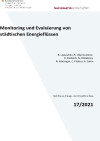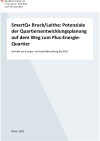Suchergebnisse
REC-Businesspark - Erforschung des ersten österreichischen Erneuerbare-Energiegemeinschaften Gewerbe- und Industrieparks
Im Zuge des Projekts erfolgte die Konzeptionierung eines Zero-Emission- bzw. Plus-Energie-Gewerbeparks in Weiz mit Fokus auf Photovoltaik und Brennstoffzelle in Kombination mit einer Erneuerbaren Energiegemeinschaft (E-EGe). Durch die Gründung auf der "grünen Wiese" können sämtliche Strukturen entsprechend den Anforderungen der E-EGe geschaffen werden.
Plus Energie Melk - Pfad für die Realisierung von Plus-Energie-Arealen in Melk
Die Stadt Melk hat sich als Ziel gesetzt, eine Vorreiterrolle im Bereich erneuerbare Energieversorgung und Klimaschutz einzunehmen. Dabei wird in einer Initiative angestrebt, Plus-Energie Areale umzusetzen. In zwei Stadtentwicklungsprojekten wird geprüft, unter welchen Rahmenbedingungen, technischen und organisatorischen Lösungen Plus-Energie Areale realisierbar sind. Ein proaktiver Beteiligungsprozess zielt darauf ab, Bauherrn und Investoren sowie andere Stakeholder von der Realisierung der Plus-Energie Konzepte zu informieren.
plusenergy-FLAGSHIP: Plusenergie-Bürogebäude 2.0 - die viadonau Unternehmenszentrale
Für die neue Unternehmenszentrale der viadonau (via donau - Österreichische Wasserstraßen-Gesellschaft m.b.H.) sollen im Zuge des gegenständlichen Projekts verschiedene Innovationen in Richtung eines „Plus-Energie Standard 2.0“ umgesetzt und in einem Gesamtkonzept vereint werden.
plusenergy-FLAGSHIP: Plus-Energy office building 2.0 - the viadonau headquarters
In the course of this project, various innovations towards a "Plus-Energy Standard 2.0" are to be implemented and combined in an overall concept for the new viadonau headquarters (via donau - Österreichische Wasserstraßen-Gesellschaft m.b.H.).
Plus-Energie-Campus - Energieflexibler Plus-Energie-Campus mit Living Lab
Im Projekt Plus-Energie-Campus wurden Wege zu einem nachhaltigen, zukunftssicheren Plusenergie-Quartier (PED) im Umfeld des Standorts der Fachhochschule Technikum Wien untersucht. Dabei wurde die Machbarkeit eines neuen Universitätsgebäudes als Plusenergie-Lehrgebäude im Detail untersucht und dessen Umsetzung vorbereitet. Zentrale Innovationsinhalte sind die energetische Flexibilisierung des Neubaus und des Quartiers sowie die Konzeption des Plusenergiehauses als "Living Lab".
Monitoring und Evaluierung von städtischen Energieflüssen

Ausgangsbasis für das Projekt sind die Energiestatistiken. In einem ersten Schritt wird die Erhebungsmethodik im Detail analysiert. Basierend auf den Erkenntnissen der Analyse wird eine Methodik zur Erstellung städtischer Energieflüsse erstellt. Diese wird mithilfe des zu entwickelnden Planungsinstruments "Senflusk" an 5 Referenzstädten getestet.
Schriftenreihe
17/2021
B. Lepuschitz, R. Obernosterer, H. Daxbeck, N. Kisliakova, N. Hörzinger, C. Ploiner, A. Sahin Berichte aus Energie- und Umweltforschung 17/
Herausgeber: BMK
Deutsch, 65 Seiten
Downloads zur Publikation
ZQ3Demo - Implementation of urban Future Quarters including stakeholder integration and legally and economically replicable solutions
ZQ3Demo accompanies three innovative urban quarters in Vienna to demonstrate and further develop ecologically and economically sustainable solutions for the implementation of Plus-Energy-Quarters (PEQ) on the basis of real-life examples.
ZQ3Demo - Umsetzung von urbanen ZukunftsQuartieren mit Akteursvernetzung und rechtlich‐ökonomisch replizierbaren Lösungen
ZQ3Demo begleitet drei innovative, urbane Quartiere, um an realen Beispielen ökologisch wie ökonomisch nachhaltige Lösungswege für die Umsetzung von Plus-Energie-Quartieren (PEQ) zu demonstrieren und weiterzuentwickeln.
SmartQ+ Bruck/Leitha - Potenziale der Quartiersentwicklungsplanung auf dem Weg zum Plus-Energie-Quartier
Erstmalige Verknüpfung von Verkehrs- und Energiesimulationsmodellen für die kommunale Planung um (Energie-) Einsparungspotenziale in der Siedlungsentwicklung bzw. die Auswirkungen von Planungsvorhaben auf die Mobilitätsnachfrage und das Energienetz einer Gemeinde in einer interaktiven Visualisierung sichtbar zu machen.
SmartQ+ Bruck/Leitha - Energy saving potentials through neighbourhood and community planning
First-time linking of transport and energy simulation models for municipal planning in order to visualise (energy) saving potentials in settlement development and effects of planning projects on mobility demand and the energy network of a municipality in an interactive visualisation.
SmartQ+ Bruck/Leitha: Potenziale der Quartiersentwicklungsplanung auf dem Weg zum Plus-Energie-Quartier

Erstmalige Verknüpfung von Verkehrs- und Energiesimulationsmodellen für die kommunale Planung um (Energie-) Einsparungspotenziale in der Siedlungsentwicklung bzw. die Auswirkungen von Planungsvorhaben auf die Mobilitätsnachfrage und das Energienetz einer Gemeinde in einer interaktiven Visualisierung sichtbar zu machen.
Schriftenreihe
88/2025
S. Bindreiter, Y. Şişman, L. Rast, S. Sint, S. Hinterseer, E. Selz, K. Mottl, R. Roggenbauer
Herausgeber: BMIMI
Deutsch, 122 Seiten
